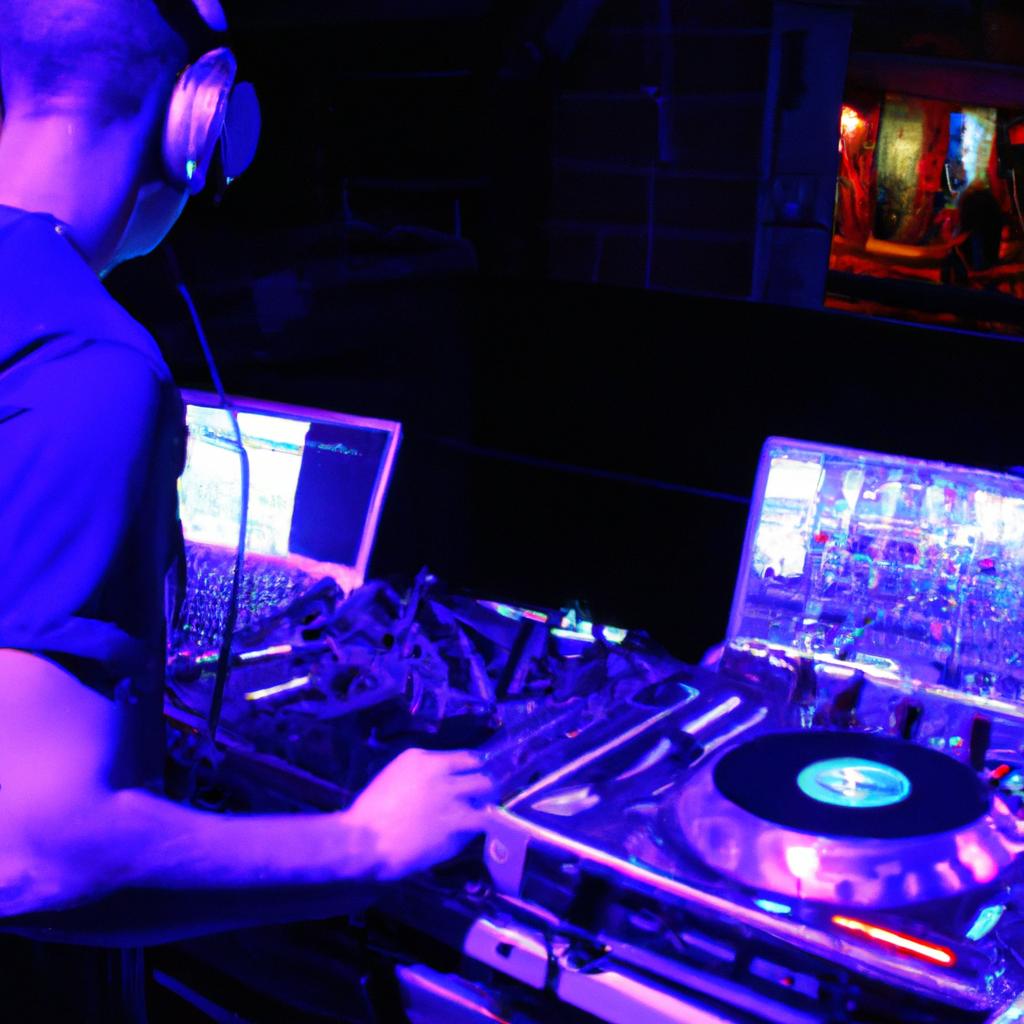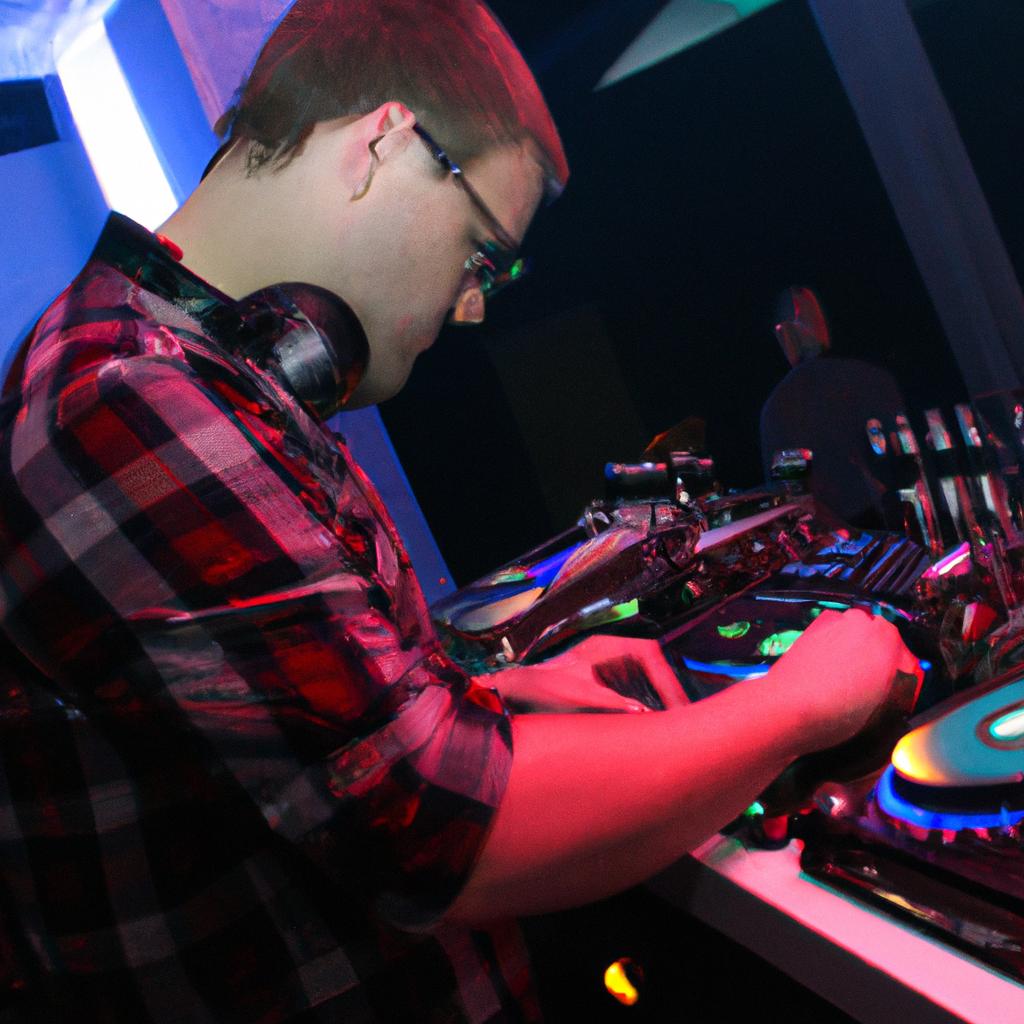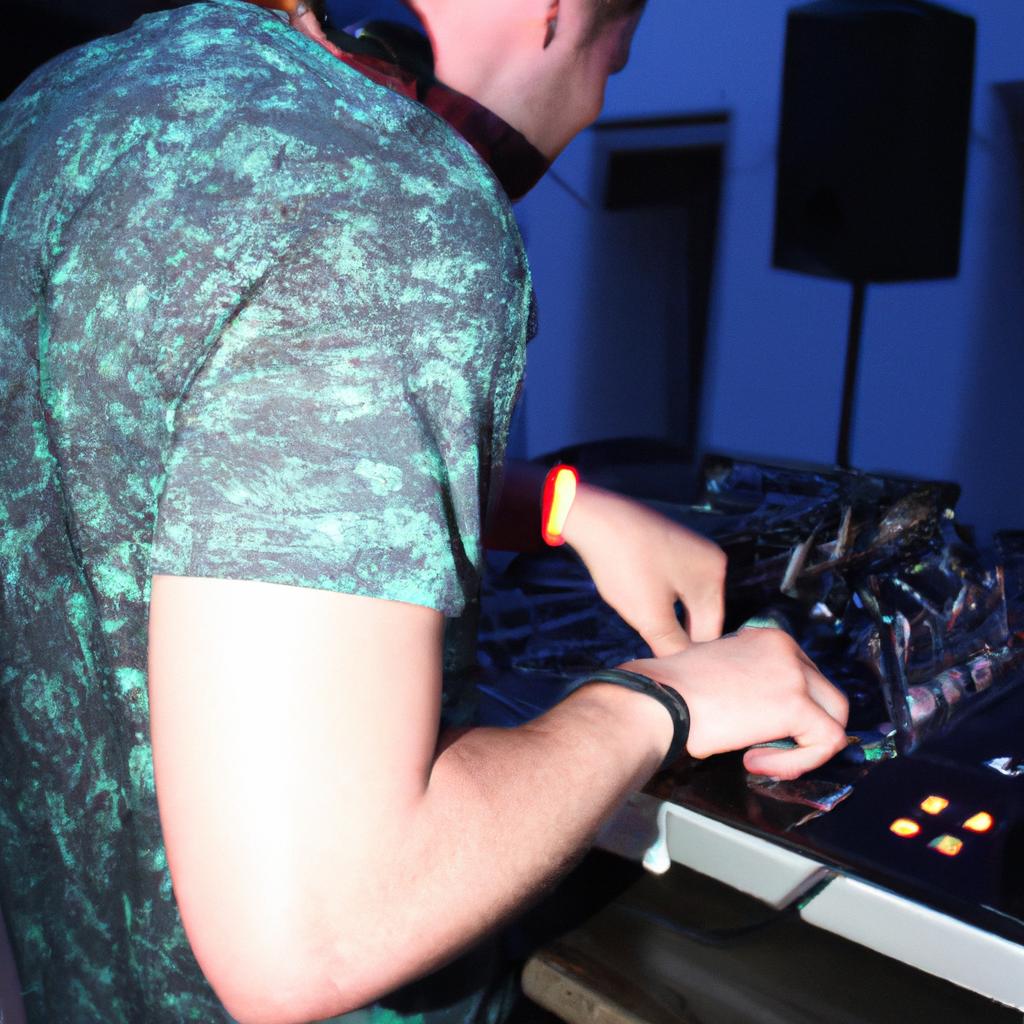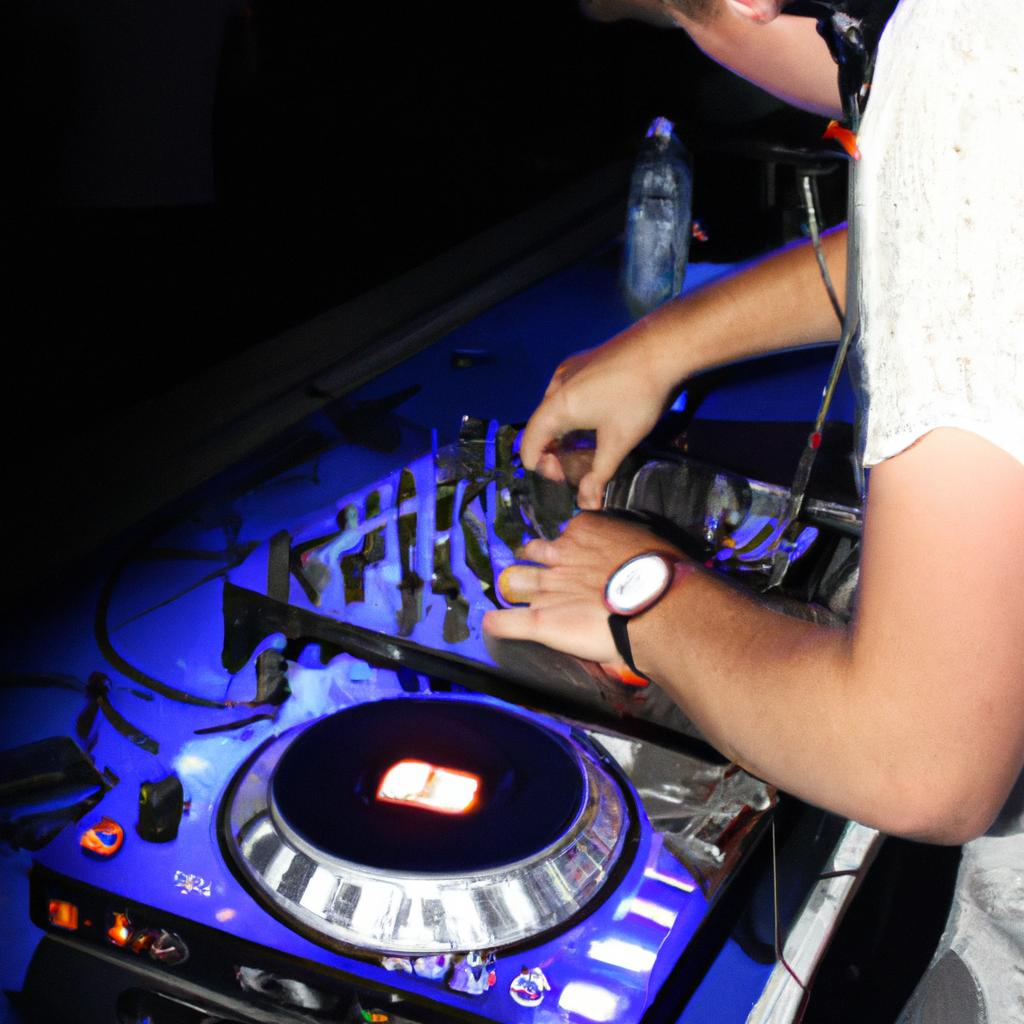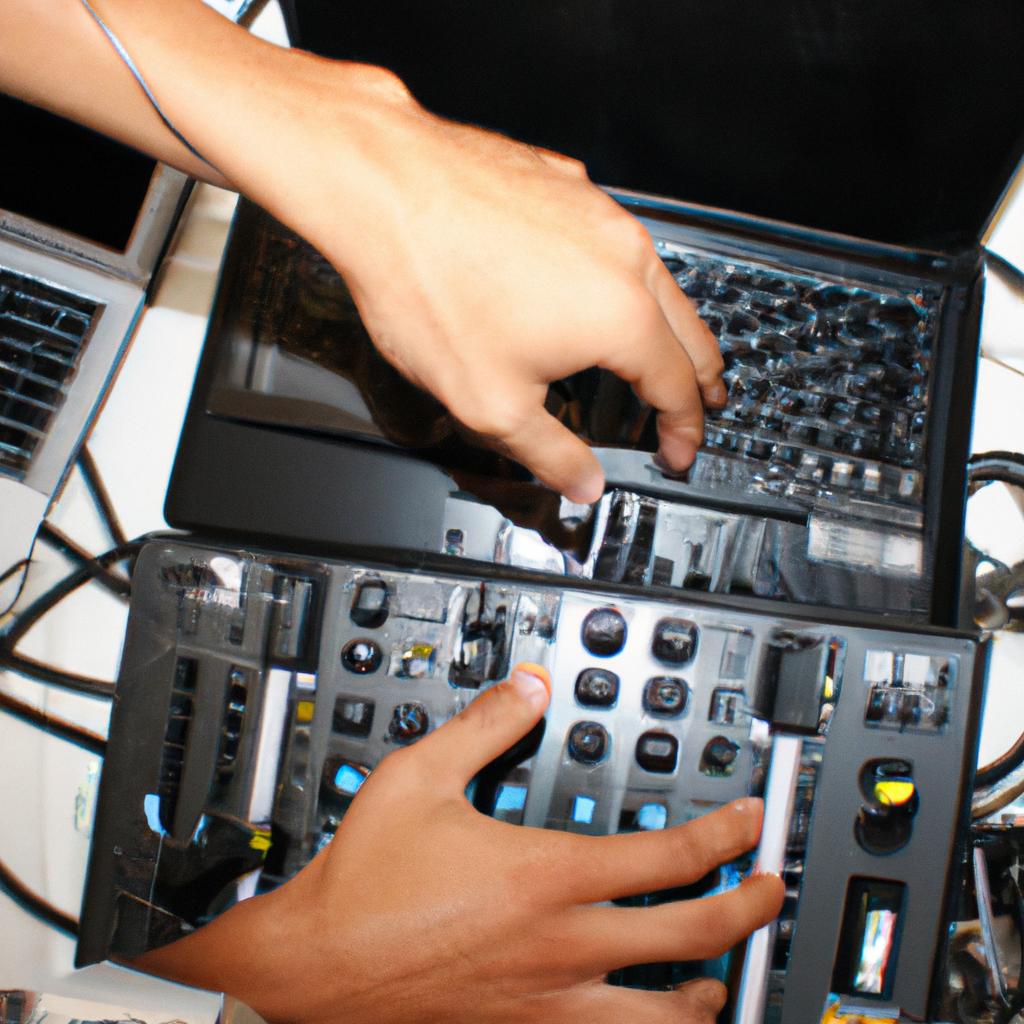Mastering the Sound: Unleashing DJ Techniques for Electrifying Dance & Nightclub Performances

In the realm of dance and nightclub performances, DJs hold a unique position as masters of sound manipulation. Their ability to blend tracks seamlessly, create innovative transitions, and manipulate audio effects has become an integral part of creating electrifying atmospheres that resonate with audiences. Whether it be the pulsating beats at a packed nightclub or the energetic vibe on a festival stage, mastering DJ techniques is essential for delivering unforgettable experiences.
To illustrate the power of these techniques, let us imagine a scenario where a renowned DJ is performing at a popular club. As the night progresses and the crowd’s energy reaches its peak, the DJ decides to introduce a surprise element into their set: live remixing. By using advanced looping techniques and sampling elements from different genres, they effortlessly fuse together familiar melodies with unexpected twists, captivating the audience’s attention and further fueling their excitement. This case study exemplifies how DJs harness their skills in sound manipulation not only to provide enjoyable entertainment but also to elevate moments of collective euphoria.
Understanding DJ Equipment
Imagine yourself at a packed nightclub, the pulsating beats penetrating every inch of your body as the crowd moves in sync with the music. At the center of it all is the DJ, seamlessly blending tracks and creating an electrifying atmosphere. Behind this mesmerizing performance lies a deep understanding of DJ equipment and its role in delivering an unforgettable experience.
To embark on this journey, let us first explore the essential components that make up a DJ setup. The cornerstone of any DJ’s arsenal is the mixer, which serves as both the control center and creative hub. It allows DJs to manipulate different audio sources, adjust volume levels, apply effects, and smoothly transition between songs. Additionally, turntables or CDJs are used to play physical or digital music files respectively, providing a tactile interface for DJs to interact with their music collection.
Once equipped with these fundamental tools, DJs can dive into an array of techniques that elevate their performances to new heights. Let us uncover some key aspects worth considering:
-
Effect processors: These devices enable DJs to add layers of creativity by applying various sound effects such as reverb, delay, or distortion. By skillfully utilizing effect processors within their mixes, DJs can create unique sonic landscapes that captivate listeners’ attention.
-
Looping capabilities: Loops allow DJs to repeat specific sections of a track seamlessly. This technique not only extends parts of a song but also offers opportunities for improvisation and remixing live on stage.
-
Sampling functionality: Modern DJ equipment often includes sampling features that empower performers to incorporate snippets from other tracks or custom sounds during their sets. This adds another layer of originality and personalization to each performance.
-
Integration with software platforms: Many professional-grade mixers now offer integration with popular DJ software applications like Serato or Traktor. This synergy enables seamless synchronization between hardware and software while unlocking advanced features like beatgridding for precise tempo matching.
By familiarizing themselves with the intricacies of DJ equipment, performers gain a solid foundation to unleash their creativity and push boundaries. The following section will delve into exploring beatmatching techniques, laying the groundwork for seamless transitions between tracks without missing a step. So let us embark on this rhythmic journey together, as we uncover the secrets behind electrifying dance and nightclub performances.
Exploring Beatmatching Techniques
In the previous section, we delved into the intricate world of DJ equipment and its significance in achieving a seamless performance. Now, let’s explore beatmatching techniques that will elevate your skills as a DJ to new heights.
Imagine this scenario: you are performing at a popular nightclub, the crowd eagerly awaiting your next move. As the current track nears its end, you seamlessly transition into a new song with synchronized beats, sending waves of energy through the dance floor. This is the power of beatmatching – aligning tempo and rhythm between two tracks for an uninterrupted mix.
To master beatmatching, consider these key factors:
-
Tempo matching: Ensure that both tracks have similar tempos by adjusting their BPM (beats per minute) values accordingly. Utilize pitch control on your mixer or software to speed up or slow down songs without affecting their natural pitch.
-
Phrase matching: Pay attention to musical phrases within each track and aim to transition during breaks or sections where vocals or melodies subside momentarily. This creates a smooth flow while avoiding clashing elements from different songs.
-
Cueing: Use headphones to preview incoming tracks before introducing them to the audience. By cueing specific points in a song, such as the first beat of a bar or significant transitions, DJs can anticipate when to bring it into play seamlessly.
-
Manual adjustments: While modern technology offers automatic sync features, refining manual beatmatching skills adds authenticity and versatility to your performances. Train your ears to detect slight variations and make precise adjustments using jog wheels or turntables if available.
By incorporating these beatmatching techniques into your repertoire, you will captivate audiences with electrifying mixes that keep them grooving all night long.
Now that we’ve explored how understanding DJ equipment enhances your craft and uncovered the secrets behind flawless beatmatching, let’s dive deeper into harnessing the power of effects and samples – an essential aspect of creating dynamic and captivating performances.
Harnessing the Power of Effects and Samples
Section: Exploring Beatmatching Techniques
In the previous section, we delved into the art of beatmatching and its significance in DJ performances. Now, let us turn our attention to another crucial aspect of mastering the sound – harnessing the power of effects and samples. By skillfully incorporating these elements into your mixes, you can elevate your dance and nightclub performances to electrifying heights.
To illustrate this point, consider a hypothetical scenario where a DJ is performing at a vibrant nightclub. As the energy on the dancefloor reaches a fever pitch, the DJ decides to introduce an effect known as “filter sweep” during a climactic moment in the track. With precision timing, they gradually manipulate the filter knob on their mixer, gradually emphasizing certain frequency ranges while reducing others. This creates a dynamic sonic shift that resonates with the audience’s excitement, intensifying their connection to the music.
When it comes to utilizing effects and samples effectively, there are several techniques worth exploring:
- Echo/Delay: Adding echoes or delays can create depth and dimension within your mixes.
- Reverb: Applying reverb can enhance ambiance by simulating different acoustic environments.
- Looping: Using loops allows for extended sections of specific sounds or beats, which can build anticipation or provide continuity between tracks.
- Sampler Triggering: Triggering samples at strategic moments can inject surprise or familiarity into your sets.
Table: Emotional Response Elicited Through Effects and Samples
| Emotional Response | Effect/Sample Technique |
|---|---|
| Excitement | Echo/Delay |
| Immersion | Reverb |
| Anticipation | Looping |
| Surprise/Familiarity | Sampler Triggering |
By judiciously employing these techniques along with others available in your arsenal, you have the ability to create memorable moments that resonate deeply with your audience. Seamlessly blending various effects and samples into your mixes can transport listeners on a sonic journey, evoking emotions and enhancing their overall experience.
Transitioning smoothly to our next section about “Mixing Tracks Seamlessly,” we will explore how the art of seamlessly transitioning between tracks contributes to creating an uninterrupted flow that keeps the dancefloor moving.
Mixing Tracks Seamlessly
Transition from Previous Section H2:
With a firm grasp on the power of effects and samples, DJs can now delve into the art of seamlessly mixing tracks. By skillfully blending different songs together, they can create electrifying dance and nightclub performances that keep the crowd moving all night long.
Section – Mixing Tracks Seamlessly
To understand the essence of seamless track mixing, let’s consider an example scenario. Imagine you are at a vibrant nightclub where the energy is palpable. The current track playing has reached its peak moment, with pulsating beats resonating through every corner of the room. As a DJ, your task is to transition smoothly into another song that will maintain or even elevate this energetic atmosphere.
To achieve a flawless mix, there are several techniques and considerations that DJs employ:
- Beatmatching: Ensuring both tracks have matching tempos by adjusting their speed manually or using specialized software.
- Phrasing: Identifying appropriate moments in each song to blend them together harmoniously without disrupting the overall flow.
- EQ Control: Skillfully manipulating equalizer controls to emphasize certain frequencies while transitioning between tracks for a cohesive sound.
- Crossfading: Gradually reducing the volume of one track while simultaneously increasing the volume of another during transitions.
Here are four essential elements crucial for achieving seamless track mixes:
- Precise timing
- Creative phrasing
- Smooth EQ adjustments
- Expert crossfading
Additionally, we can visualize how these techniques come together through a table showcasing their impact on creating an engaging atmosphere:
| Techniques | Impact |
|---|---|
| Beatmatching | Maintains rhythmic flow |
| Phrasing | Enhances musical journey |
| EQ Control | Customizes tonal balance |
| Crossfading | Ensures smooth transitions |
By skillfully applying these techniques, DJs can create a captivating experience that keeps the dance floor packed and the energy high. The ability to seamlessly mix tracks is an art form in itself, allowing DJs to curate a musical journey for their audience, ensuring maximum enjoyment throughout the night.
Transition:
As crucial as seamless track mixing may be, it is equally important for DJs to read the crowd and adapt their performances accordingly.
Reading the Crowd: Creating an Energetic Atmosphere
Creating an Energetic Atmosphere through Reading the Crowd
To truly captivate a crowd and deliver an electrifying performance, DJs must possess the skill of reading their audience. By understanding the energy levels and preferences of those on the dance floor, DJs can tailor their set to create a vibrant atmosphere that keeps everyone moving.
Imagine a scenario where you are performing at a popular nightclub. As you observe the crowd, you notice that they respond positively when you play high-energy tracks with heavy basslines. This insight allows you to gauge their mood and adjust your playlist accordingly, ensuring a continuous wave of excitement throughout the night.
Here are some key strategies for effectively reading the crowd:
- Observe: Pay close attention to how individuals react to different genres, tempos, and specific tracks. Look for signs of enthusiasm such as increased dancing or cheering.
- Interact: Engage with the audience by making eye contact, nodding in acknowledgment of their appreciation, and occasionally asking for feedback. These interactions provide valuable cues about what is resonating with them.
- Experiment: Introduce new tracks or remixes during your set, carefully observing how the crowd responds. This experimentation allows you to test out different styles and adapt accordingly.
- Maintain Flexibility: Be prepared to shift gears if necessary. If you sense that energy levels are dropping or certain songs aren’t connecting with the audience, quickly transition into something more captivating.
| Key Strategies | Benefits |
|---|---|
| Observe | Understand audience preferences |
| Interact | Foster connection between DJ and crowd |
| Experiment | Discover new music trends |
| Maintain Flexibility | Keep energy levels high |
By actively applying these techniques – observing, interacting, experimenting, and maintaining flexibility – DJs can effortlessly create an energetic atmosphere that resonates with the crowd. The ability to adapt and respond to audience preferences ensures a memorable night for all.
As we move forward, let’s explore the importance of perfecting transitions and building energy within your DJ sets. Emphasizing smooth transitions and gradually increasing intensity will elevate your performance to new heights, leaving the audience craving for more electrifying beats.
Perfecting Transitions and Building Energy
Transitioning seamlessly from one track to another is a crucial skill for any DJ looking to create an electrifying atmosphere on the dance floor. In the previous section, we explored techniques for reading the crowd and creating an energetic ambiance. Now, let’s delve into perfecting transitions and building energy in order to continuously captivate your audience.
To illustrate this concept, imagine you’re performing at a popular nightclub. As the night progresses, you notice that the energy level of the crowd starts to dip slightly. To reignite their enthusiasm, you decide to smoothly transition from a high-energy house track to a pulsating techno beat. By gradually introducing elements of the new track while fading out the old one, you successfully build anticipation among your listeners before delivering an explosive drop that ignites the dance floor once again.
Achieving such impactful transitions requires careful consideration and practiced technique. Here are some key strategies to help you master this art form:
- Beatmatching: Ensuring that both tracks have synchronized beats is essential for seamless transitions. Utilize features like pitch control and tempo sliders to match BPMs between songs.
- Phrase matching: Aligning musical phrases helps maintain continuity throughout your set. Look for moments where melodies or vocals naturally overlap or complement each other.
- EQ blending: Skillfully adjusting equalizer levels allows for smooth sonic integration between two tracks. Gradually attenuate frequencies of one song while boosting those of the incoming tune to achieve harmonic cohesion.
- Creative effects: Incorporating audio effects can add flair and excitement during transitions. Experiment with filters, delays, reverbs, or even loop rolls to enhance tension and engage your audience further.
Now let’s explore these techniques in more detail through a table showcasing various ways they can be employed during different parts of a mix:
| Transition Technique | Use Case | Emotional Impact |
|---|---|---|
| Echo Out | Calm breakdown sections | Creates suspense and anticipation for the upcoming drop |
| Filter Sweep | Intensifying build-ups | Adds excitement and tension as energy gradually escalates |
| Loop Roll | High-energy drops | Amplifies the impact of a climactic moment in the track |
| Reverse Reverb | Unexpected breakdowns | Surprises listeners with unique soundscapes |
In summary, mastering transitions is an art that can elevate your DJ performances to new heights. By employing techniques such as beatmatching, phrase matching, EQ blending, and creative effects, you’ll be able to seamlessly guide your audience through an electrifying sonic journey. Remember, practice makes perfect when it comes to building energy and captivating dancers on the nightclub floor. So experiment, refine your skills, and watch as your sets become unforgettable experiences for all who attend.

